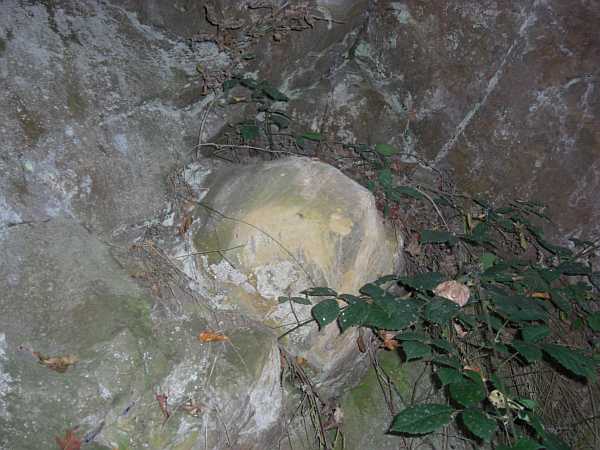Konkretion EarthCache
-
Difficulty:
-

-
Terrain:
-

Size:  (not chosen)
(not chosen)
Please note Use of geocaching.com services is subject to the terms and conditions
in our disclaimer.
A concretion is a volume of sedimentary rock in which a
mineral cement fills the porosity (i.e. the spaces between the
sediment grains). Concretions are often ovoid or spherical in
shape, although irregular shapes also occur. The word 'concretion'
is derived from the Latin con meaning 'together' and cresco meaning
'to grow'. Concretions form within layers of sedimentary strata
that have already been deposited. They usually form early in the
burial history of the sediment, before the rest of the sediment is
hardened into rock. This concretionary cement often makes the
concretion harder and more resistant to weathering than the host
stratum.
Appearance
Sandstone Concretion at Año Nuevo State ReserveConcretions vary in
shape, hardness and size, ranging from objects that require a
magnifying lens to be clearly visible to huge bodies three meters
in diameter and weighing several thousand pounds.
Composition
They are commonly composed of a carbonate mineral such as calcite;
an amorphous or microcrystalline form of silica such as chert,
flint, or jasper; or an iron oxide or hydroxide such as goethite
and hematite. They can also be composed of other minerals that
include dolomite, ankerite, siderite, pyrite, marcasite, barite and
gypsum, to name a few. Although concretions often consist of single
dominate mineral, other minerals can be present in variable amounts
depending the specific environmental conditions, which created
them. For example, carbonate concretions, which form in response to
the reduction of sulfates by bacteria, often contain variable, but
typically minor, percentages of pyrite. Other concretions, which
formed as a result of microbial sulfate reduction, consist of a
mixture of calcite, barite, and pyrite in variable proportions.
Occurrence
Concretions are found in a wide variety of rocks, and are
particularly common in shales, siltstones, and sandstones. They
often outwardly resemble fossils or rocks that look as if they do
not belong to the stratum in which they were found. Occasionally,
concretions contain a fossil, either as its nucleus or as a
component that was incorporated during its growth but concretions
are not fossils themselves. They appear in nodular patches,
concentrated along bedding planes, protruding from weathered
cliffsides, randomly distributed over mudhills or perched on soft
pedestals.
The local characteristic
Here, in the Ruhrdistrict, coal mines had a very high value. The
coal was won from the upper carbon layers. They found also the here
visible concretions. These were segregated and used in the steel
industry as additional raw material. For example the concretions
were found at the Pit Eintracht (Essen-Steele-Freisenbruch).
Task:
(1) Take a picture! Including the concretion and you.
(2) Answer the following question: Is the diameter of this
"Toneisenkonkretion" greater than 1 metre?
Please send an email with the right answer to the following
address:
yes-konkretion@fantasymail.de
or
no-konkretion@fantasymail.de
PICTURES of Sedimantary-Wall, Concretion, Informationboard

DEUTSCH
Konkretionen sind örtliche Zusammenballungen ursprünglich
gleichmäßig verteilter Stoffe, meist Kalk oder Kalkmergel,
Toneisenstein (Tone und Siderit), Kieselsäure, Schwefelkies (Pyrit,
Markasit) oder Phosphorit. Vielfach umschließen sie organische
Reste. Das Konkretionsmittel erfüllt entweder nur den Porenraum des
Sedimentes (bei den meisten Kalkkonkretionen), es kann durch
Stoffaustausch aber auch Raum gewinnen (z. B. bei
Kieselkonkretionen) oder durch seinen Kristallisationsdruck das
Muttergestein aktiv verdrängen (z.B. bei Markasitkonkretionen). Die
Bildung der Konkretionen kann ausgelöst werden durch verwesende
organische Substanz ("Verwesungskalk"), durch geänderte
Löslichkeitsverhältnisse bei aufsteigenden Porenwässern oder durch
Stoffwanderung zu Orten größerer Keimdichte.
- Die meisten Kalk-Konkretionen entstehen, wenn sich der in den
Sedimenten vorhandene Kalkanteil in alkalischem Milieu konkretionär
zusammenballt, wobei kalkige Hartteile sind als
Kristallisationszentren bevorzugt werden.
- Toneisenstein-Konkretionen hingegen brauchen zu ihrer Entstehung
ein reduzierendes Milieu. Man nimmt an, dass Porenwässer Eisen
lösen und nahe der Sedimentoberfläche wieder ausscheiden.
- Phosphorit-Konkretionen treten rein oder in Ubergängen zu
Toneisenstein- und Kalkkonkretionen auf, sie sind bei stagnierender
Sedimentation und phosphathaltigen Auftriebswässern häufig und oft
an tierische Resten und Kot gebunden.
- Schwefelkies entsteht in reduzierendem Milieu bei Anwesenheit von
Eisenionen und H2S im Überschuss. Es kommen sowohl Pyrit (regulär,
stabil) als auch Markasit (rhombisch, instabil) als
Konkretionsmittel vor.
- Kieselkonkretionen (Feuerstein, Flint, Hornstein, Silex) beziehen
ihren Rohstoff aus der Auflösung kieseliger Organismenschalen, aus
fein verteiltem sedimentärem Si02 oder aus vulkanischem Si02. Sie
bilden sich oft sehr früh, in Abhängigkeit von organischen Resten,
aber die Mobilisierung des SiO2 ist nur in basischem Milieu
möglich. Frühdiagenetische Konkretionen (d.h. sehr kurz nach der
Ablagerung der Sedimente entstanden) sind für die Erhaltung von
Fossilien besonders wichtig. Sie umhüllen diese und schützen sie
vor Zerstörung.
Lokale Bedeutung
Hier im Ruhrgebiet hat der Kohlebergbau einen sehr hohen
Stellenwert. Die Kohle wurde aus den Schichten des Oberkarbon
gewonnen. Dort fanden sich auch die hier sichtbaren Konkretionen.
Diese wurden aussortiert und in der Stahlindustrie als zusätzlicher
Rohstoff eingesetzt. Beispielsweise wurden die Konkretionen massiv
auf Zeche Eintracht (Essen-Steele-Freisenbruch) gefördert.
Aufgabe:
(1) FOTO. Die Konkretion und Du!
(2) Beantwortet folgende Frage: Ist der Durchmesser der hier
sichtbaren Toneisenkonkretion größer als 1 Meter?
Antwortet bitte auf Englisch, und zwar kurz und bündig mit einem
einfachen "Yes" oder "No" und benutzt die dafür eingerichtet
Email-Adresse:
yes-konkretion@fantasymail.de
oder
no-konkretion@fantasymail.de
Additional Hints
(No hints available.)